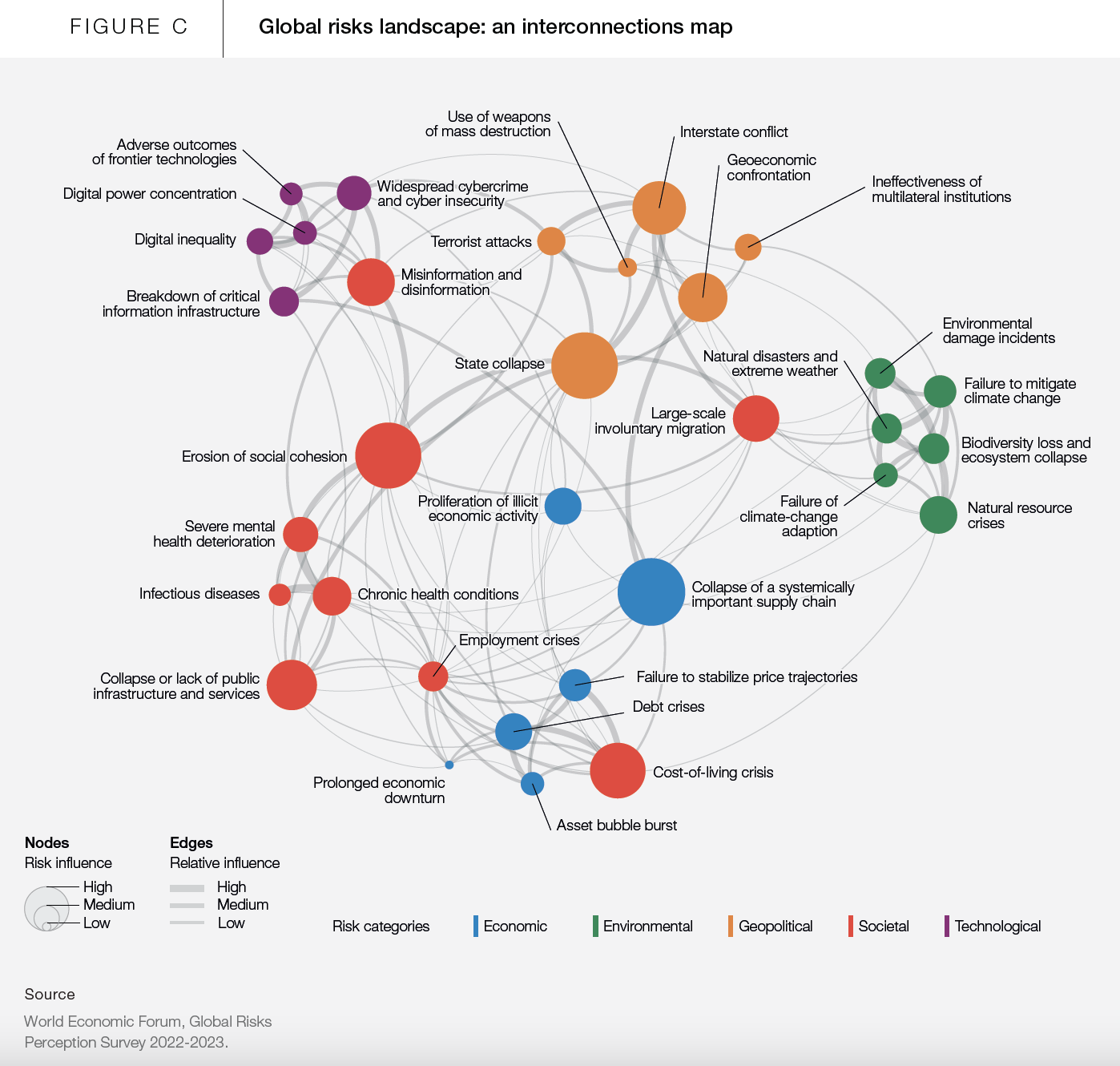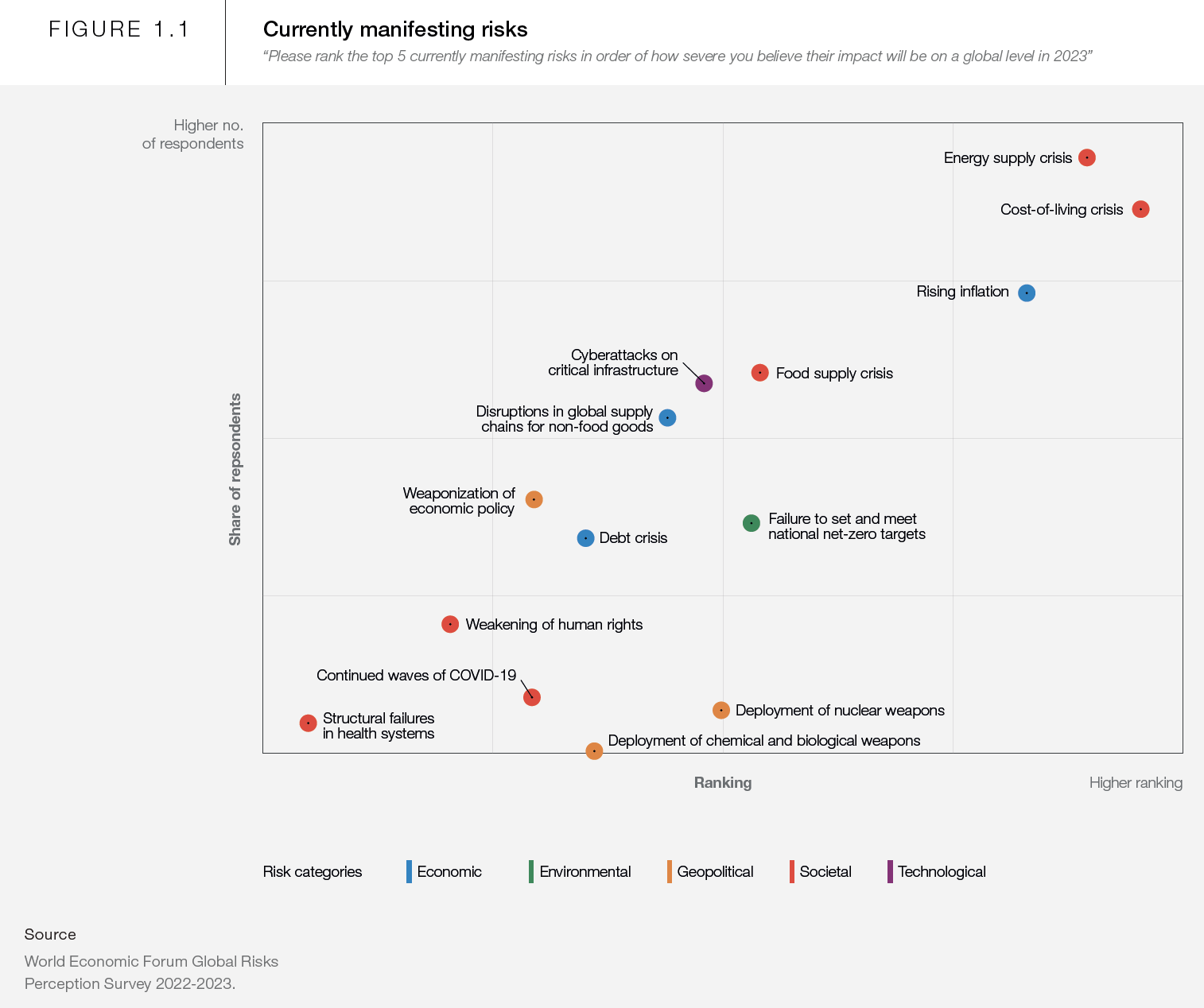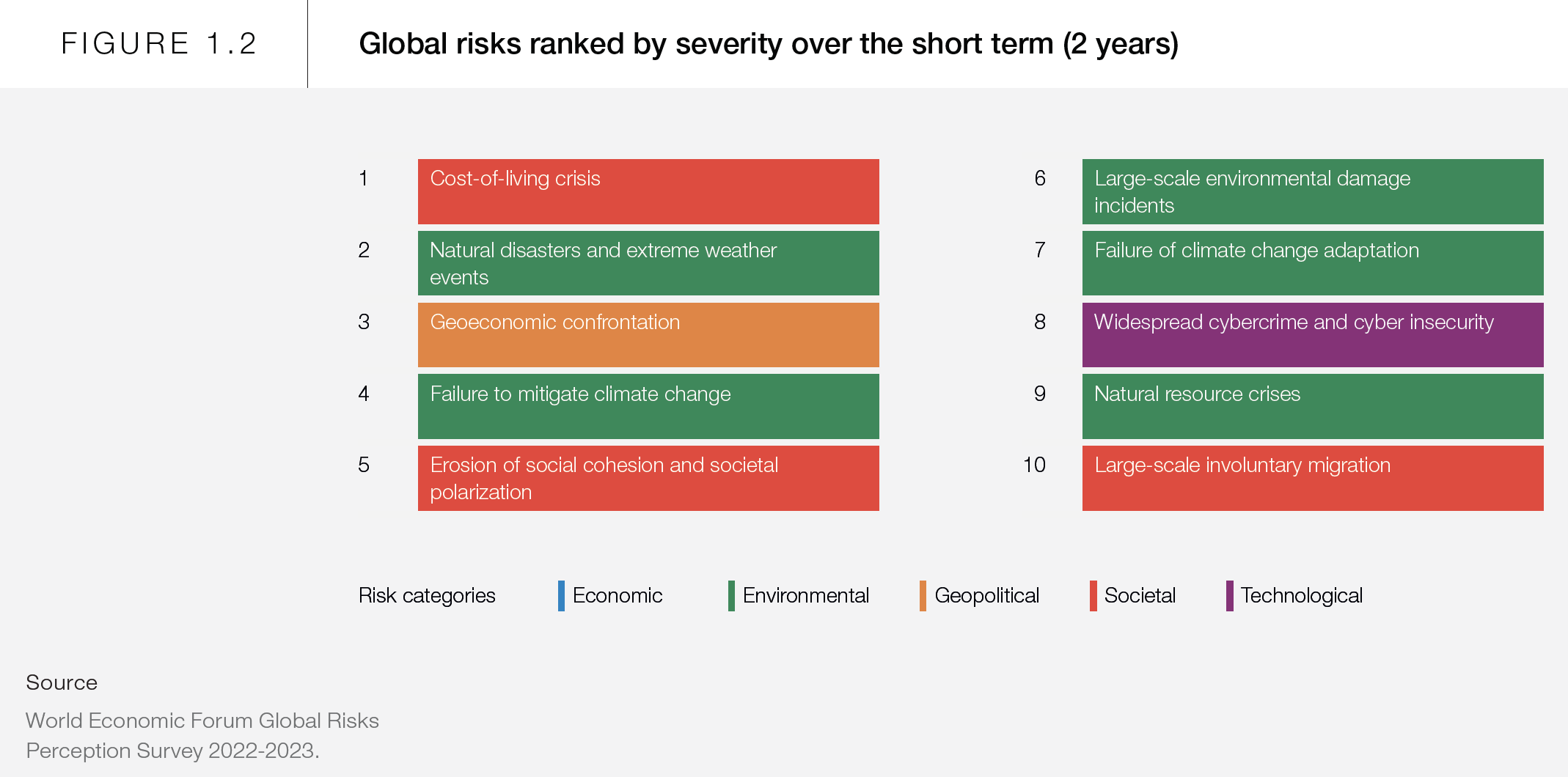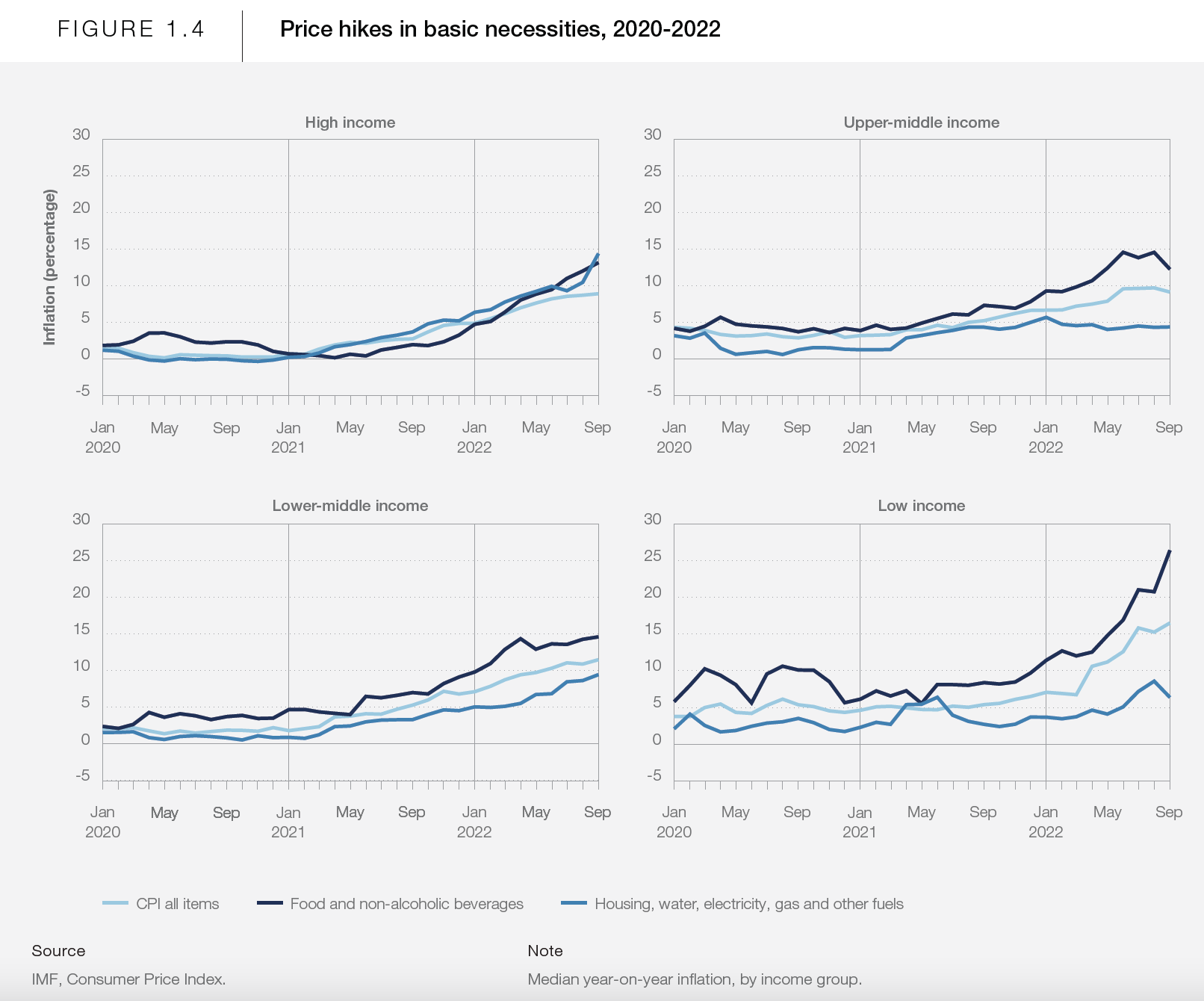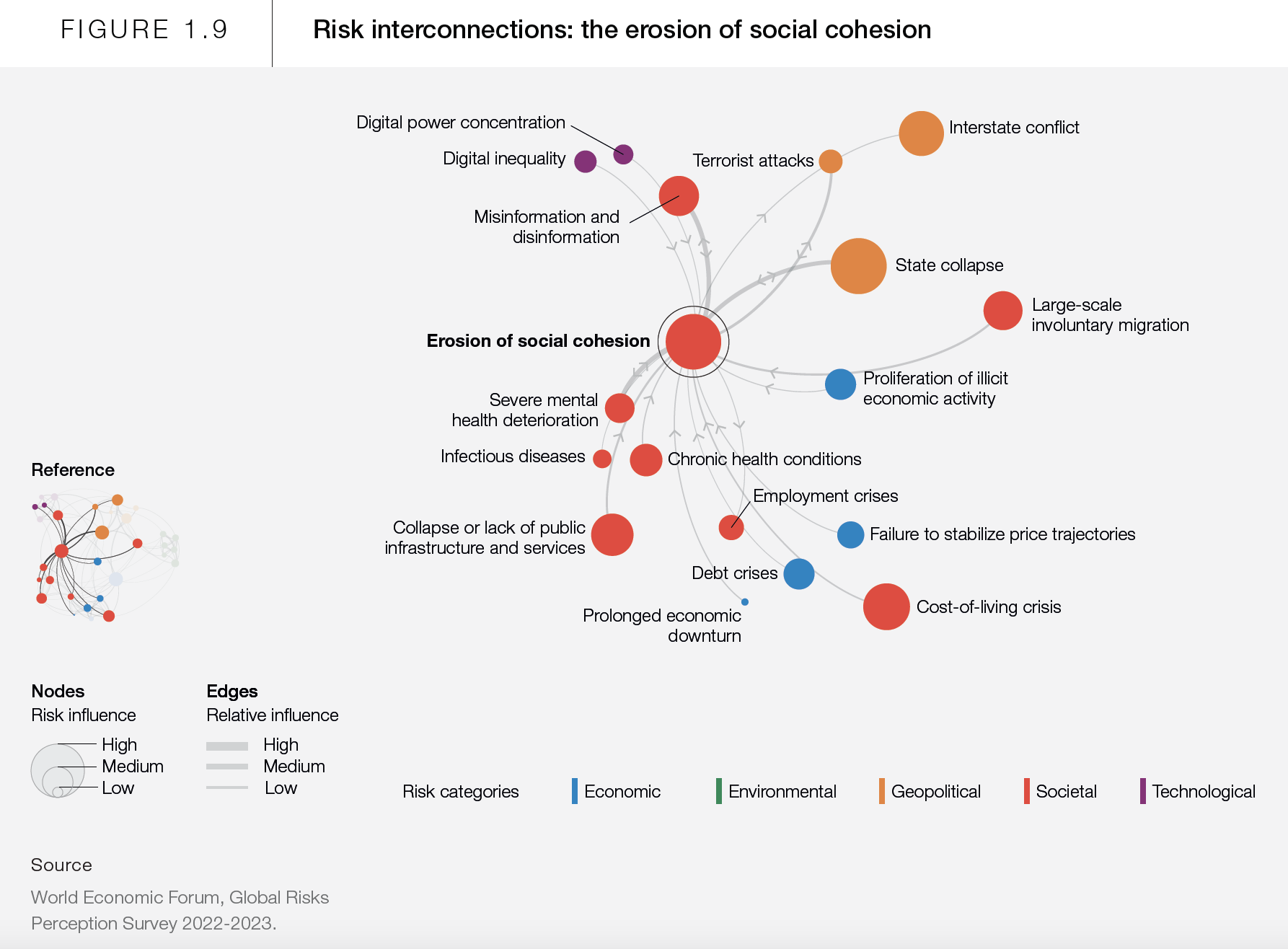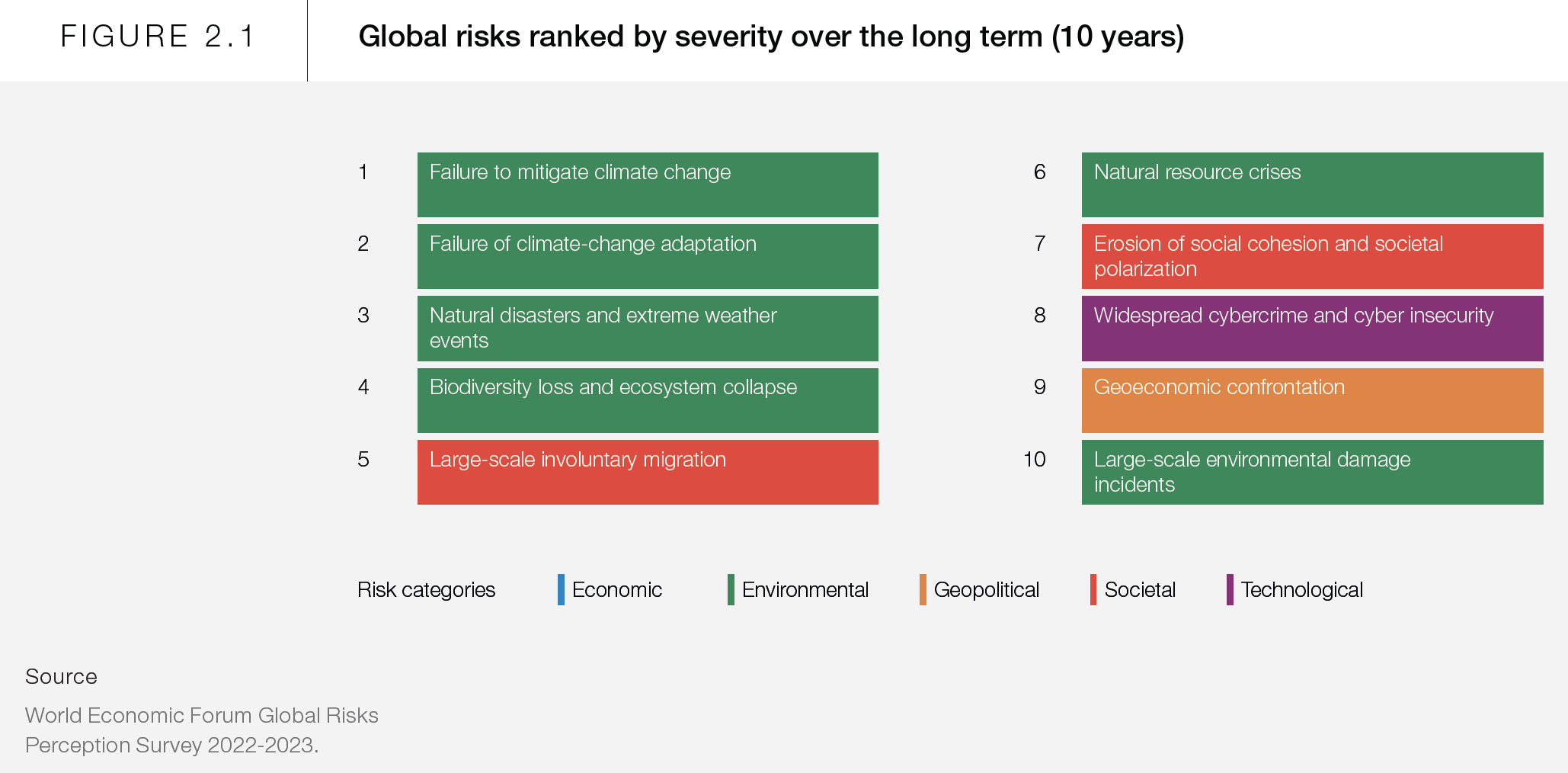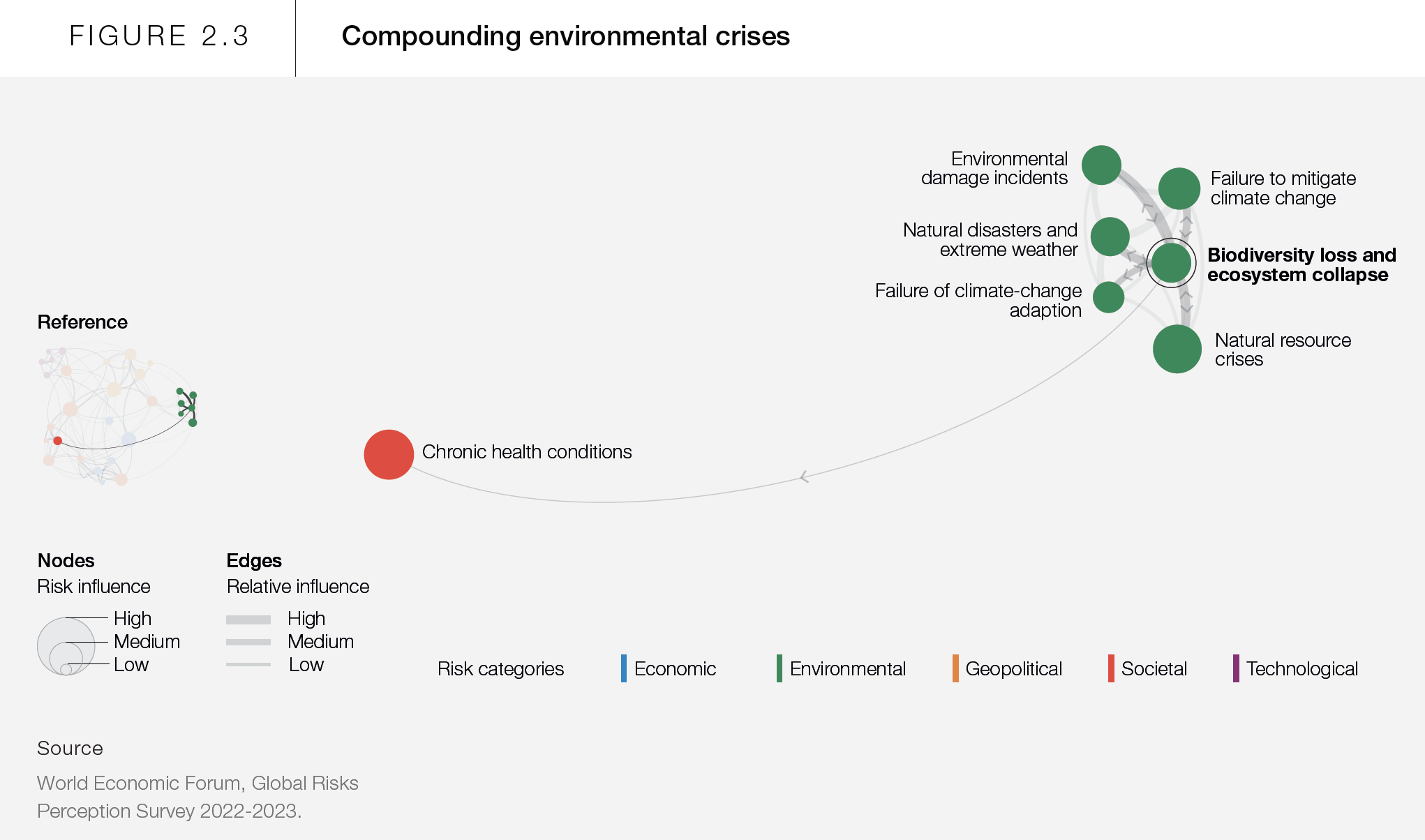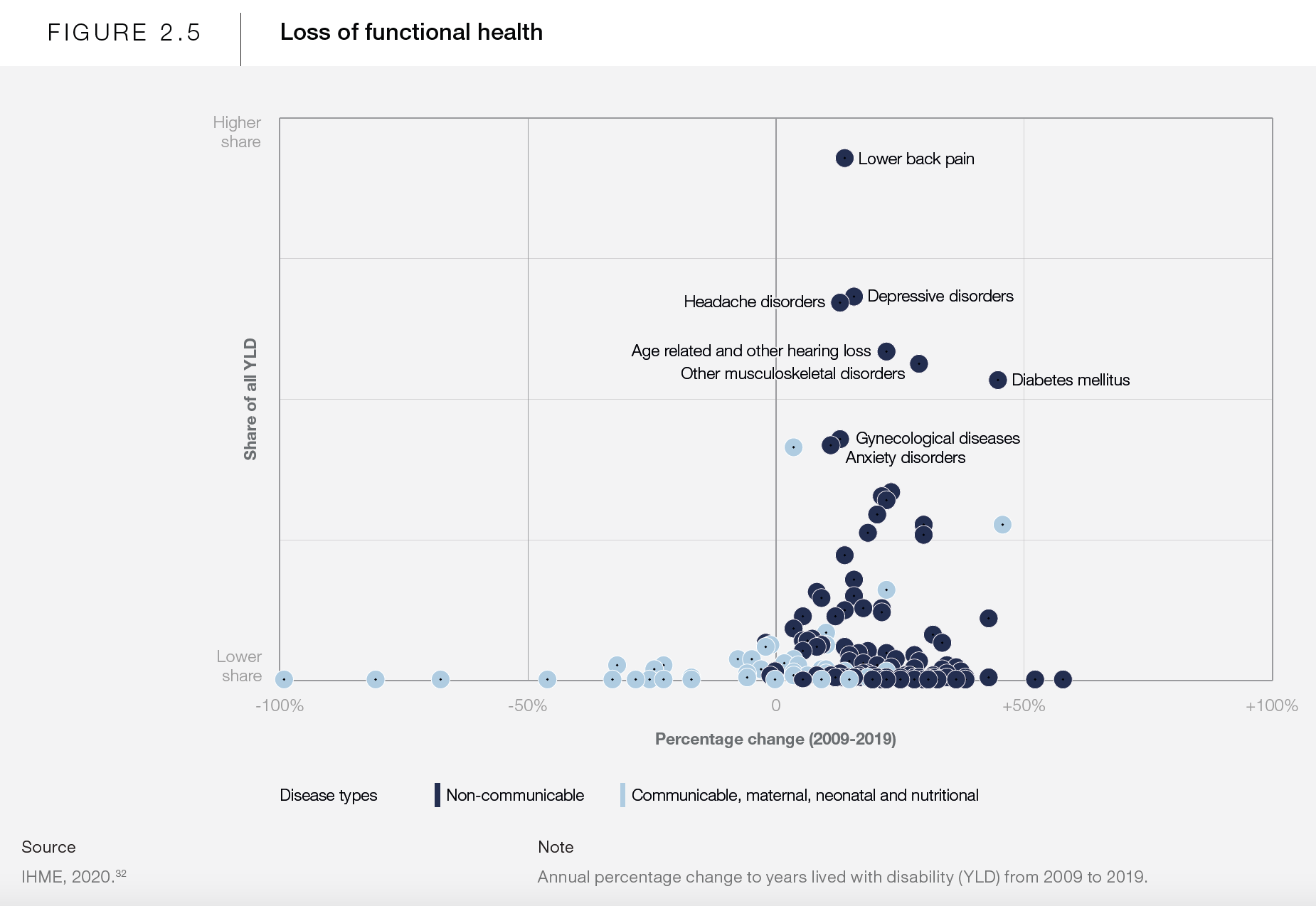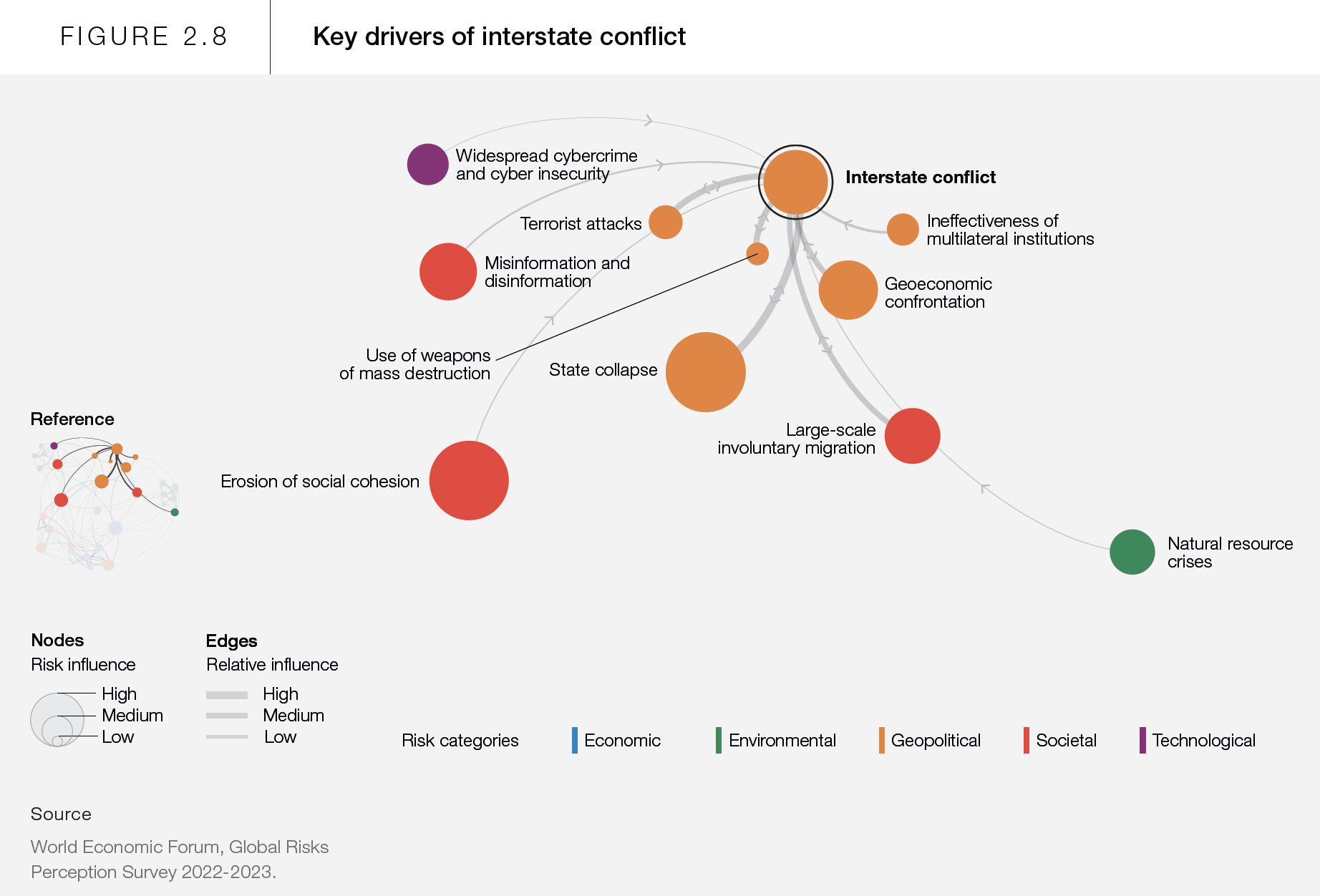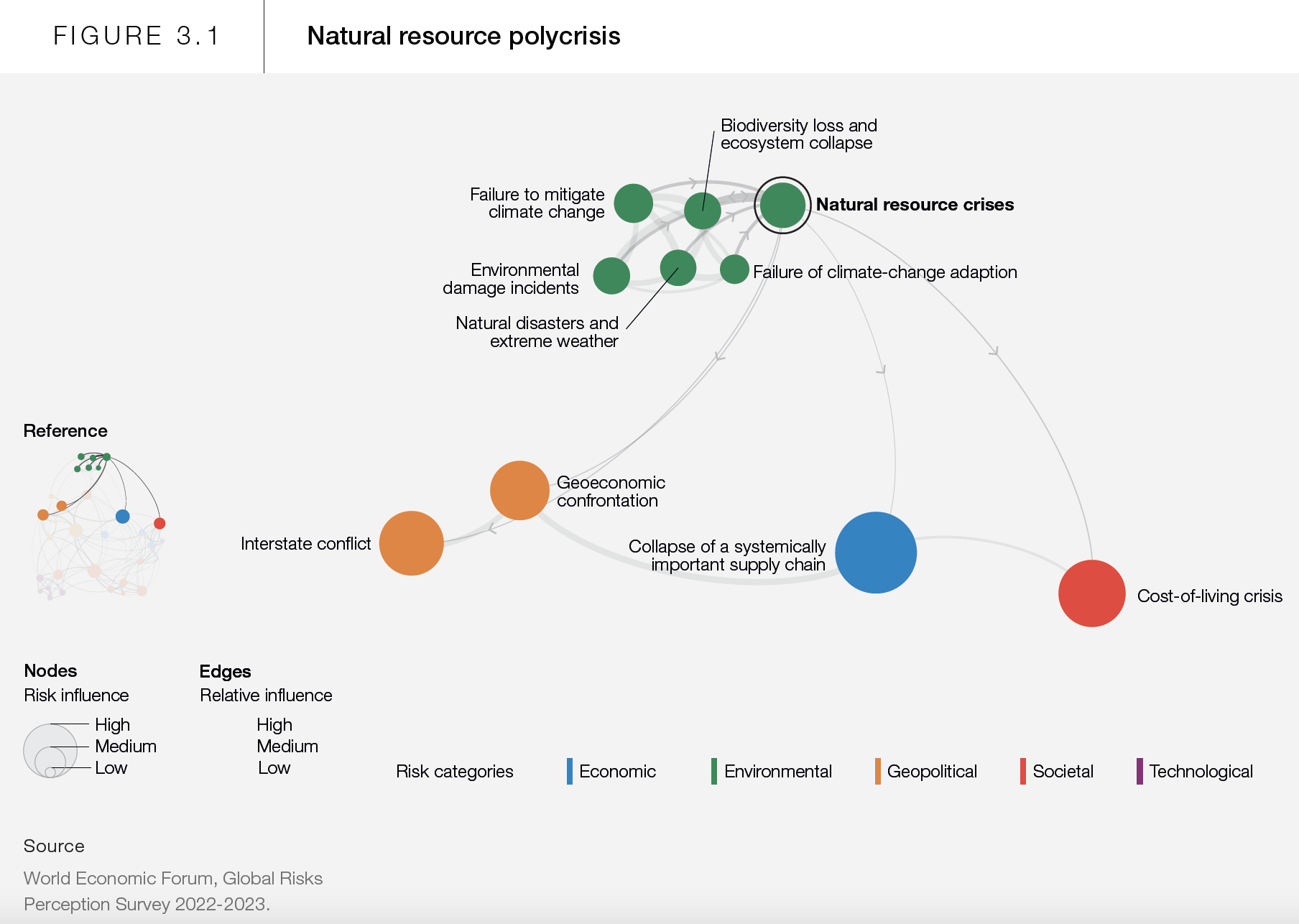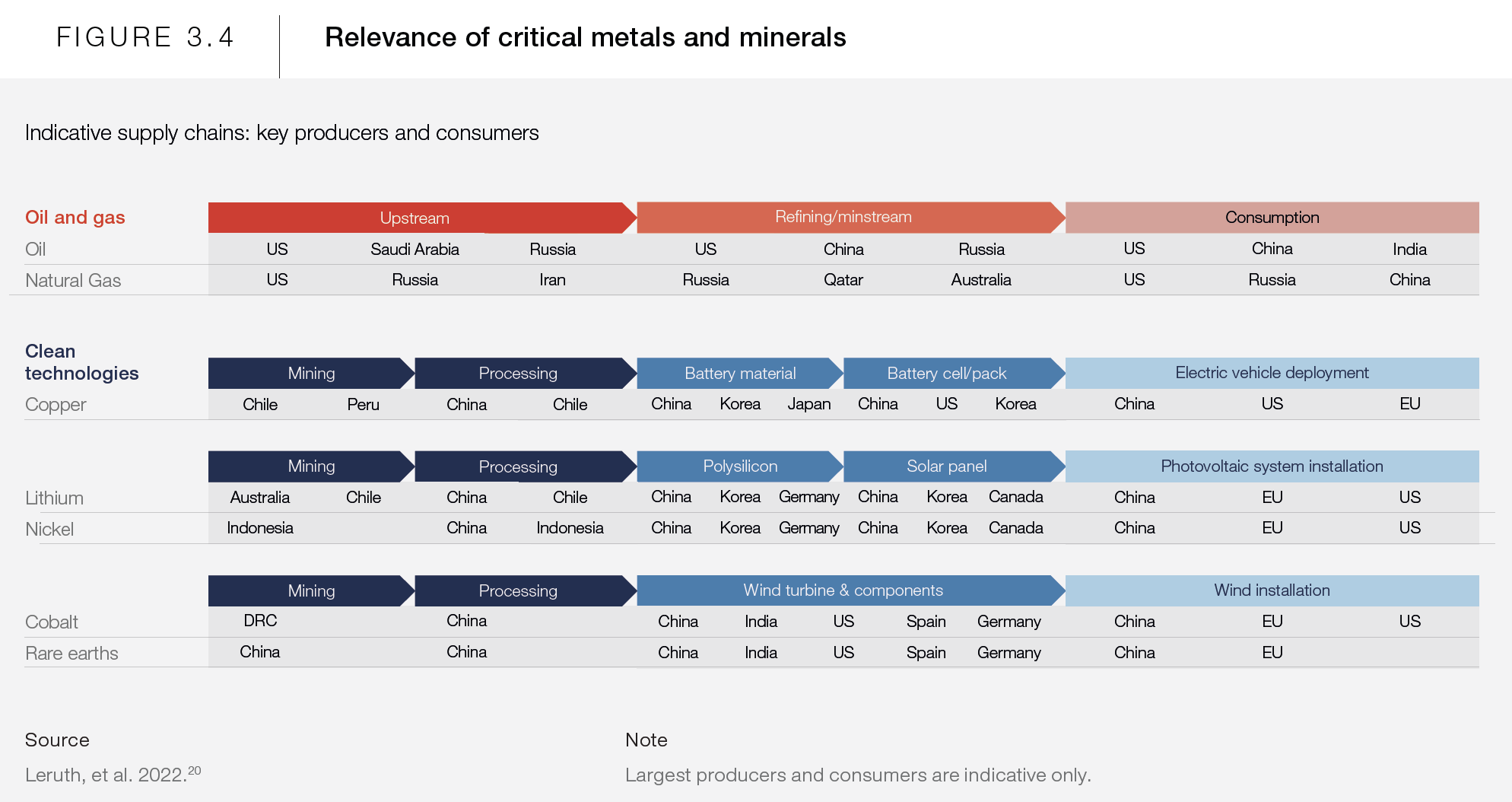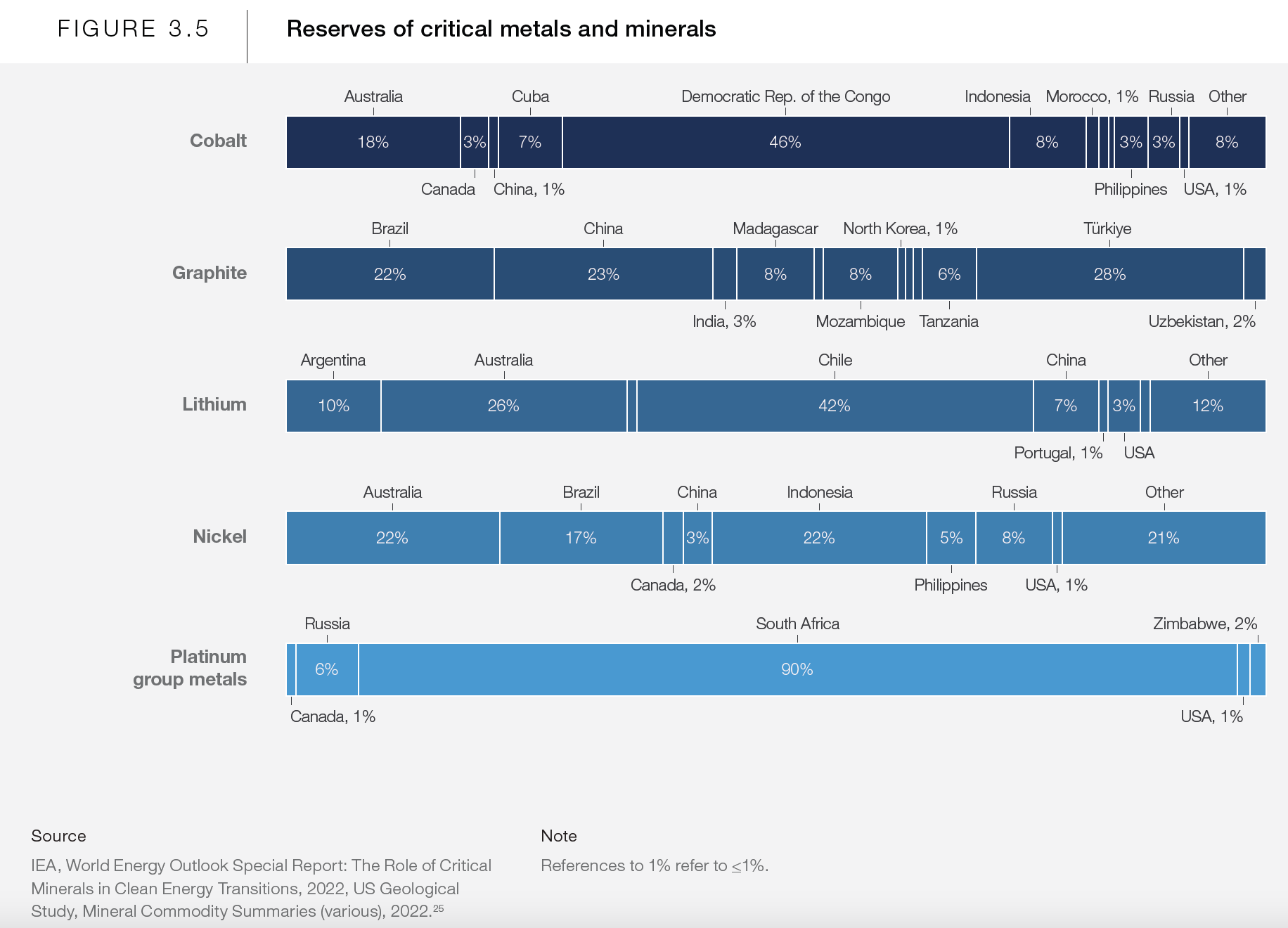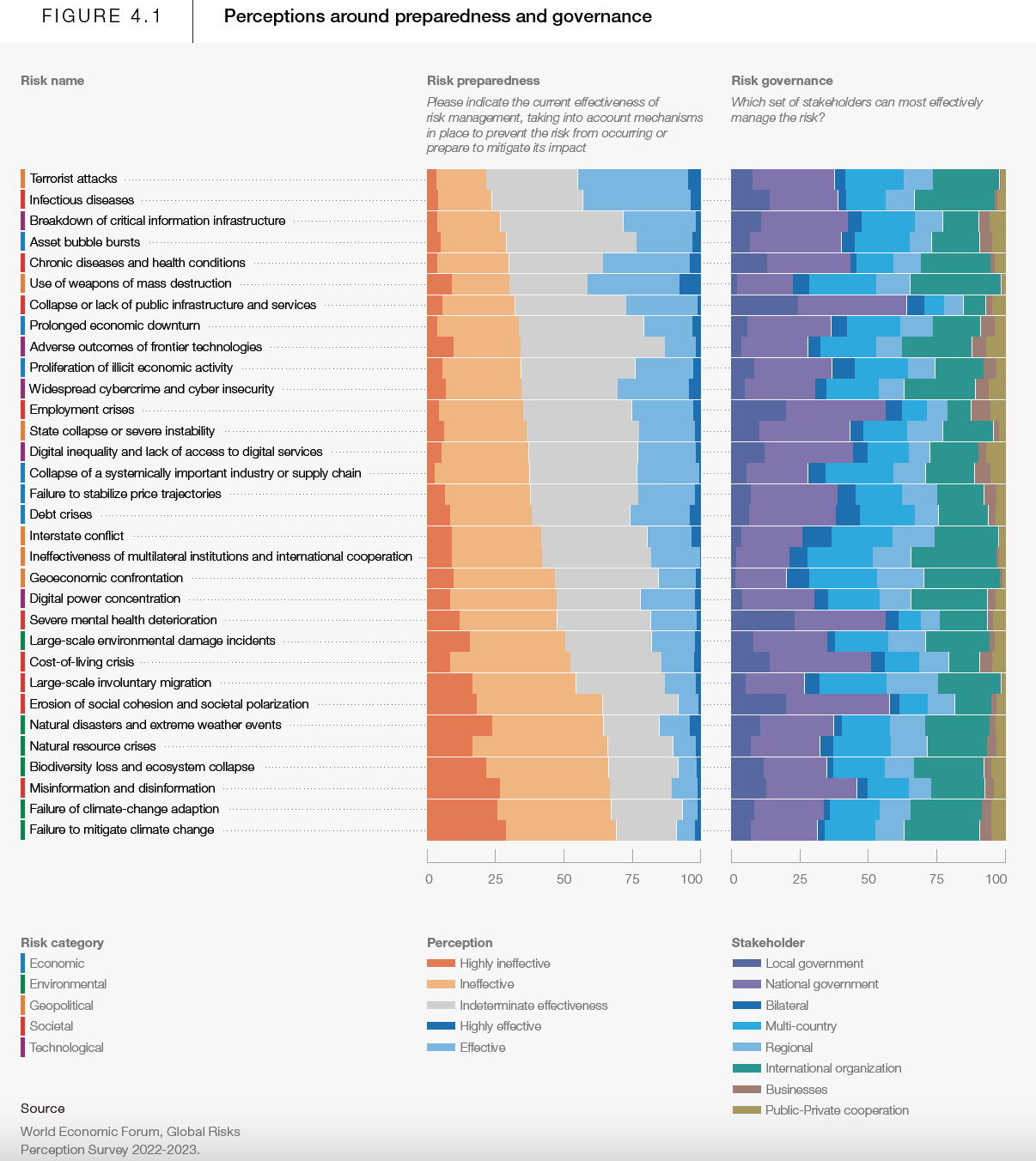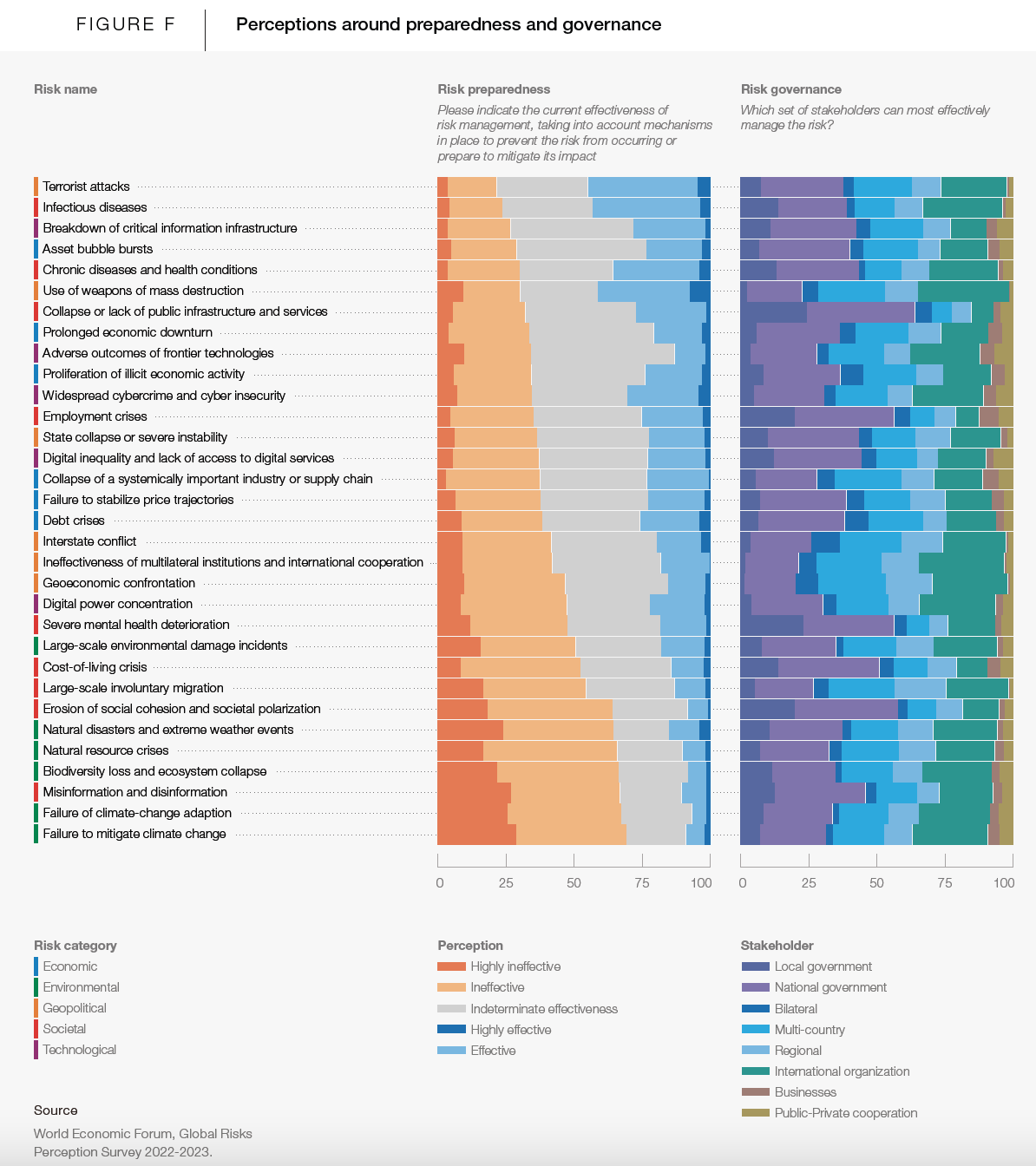2023 Global Risk Report by the WEF
Ref: World Economic Forum (2023). The Global Risk Report, 18th Edition.
___________________________________________________________________________
Summary
As 2023 begins, the world is facing a set of risks that feel both wholly new and eerily familiar. We have seen a return of “older” risks – inflation, cost-of-living crises, trade wars, capital outflows from emerging markets, widespread social unrest, geopolitical confrontation and the spectre of nuclear warfare – which few of this generation’s business leaders and public policy-makers have experienced. These are being amplified by comparatively new developments in the global risks landscape, including unsustainable levels of debt, a new era of low growth, low global investment and de-globalization, a decline in human development after decades of progress, rapid and unconstrained development of dual-use (civilian and military) technologies, and the growing pressure of climate change impacts and ambitions in an ever-shrinking window for transition to a 1.5°C world. Together, these are converging to shape a unique, uncertain and turbulent decade to come.
The health and economic aftereffects of the pandemic have quickly spiraled into compounding crises. C emissions have climbed, as the post-pandemic global economy fired back up. Food and energy have become weaponized by the war in Ukraine, sending inflation soaring to levels not seen in decades, globalizing a cost-of-living crisis and fueling social unrest. The resulting shift in monetary policy marks the end of an economic era defined by easy access to cheap debt and will have vast ramifications for governments, companies and individuals, widening inequality within and between countries.
Recent and current events such as COVID-19 and the cost-of-living crisis are steadily eroding economic, educational and health-related gains in a widening proportion of the population, with a growing divergence between advanced and developing countries. This in turn is interacting with a multiplicity of environmental and geopolitical risks – climate change, ecosystem collapse, multi-domain conflicts – to further threaten the security and stability of societies around the world.
Today’s Crises: Cost of living, social and political polarization, food and energy supplies, tepid growth, and geopolitical confrontation, among others.
Much-needed attention and resources are being diverted from newly emerging or rapidly accelerating risks to natural ecosystems, human health, security, digital rights and economic stability that could become crises and catastrophes in the next decade.
Global Risk: The possibility of the occurrence of an event or condition which, if it occurs, would negatively impact a significant proportion of global GDP, population or natural resources.
Severity: The perceived likely impact of global risks over a one-, two- and 10-year horizon.
In this report, respondents predicted global volatility and provided context to the evolution of the global risks landscape, considered potential impacts to rising risks, and assessed the current effectiveness of the management of global risks and reflect on which stakeholders are best placed to effectively manage them, to elicit opportunities for global action and collaboration. Experts were then asked to identify new and emerging risks.
___________________________________________________________________________
Today’s Crises
The economic aftereffects of COVID-19 and the war in Ukraine have ushered in skyrocketing inflation, a rapid normalization of monetary policies and started a low-growth, low-investment era.
Current crises divert resources from risks arising over the medium to longer term
Agriculture
Estimates suggest that over 800,000 hA of farmland were wiped out by floods in Pakistan – increasing commodity prices significantly in a country that was already grappling with record 27% inflation.
Economics
The IMF’s most recent projections anticipate a decline in global inflation from almost 9% in 2022 to 6.5% this year and 4.1% in 2024, with a sharper disinflation in advanced economies.
Even if some economies experience a softer-than-expected economic landing, the end of the low interest rate era will have significant ramifications for governments, businesses and individuals. The knock-on effects will be felt most acutely by the most vulnerable parts of society and already-fragile states, contributing to rising poverty, hunger, violent protests, political instability and even state collapse. Economic pressures will also erode gains made by middle-income households, spurring discontent, political polarization and calls for enhanced social protections in countries across the world. Governments will continue to face a dangerous balancing act between protecting a broad swathe of their citizens from an elongated cost-of-living crisis without embedding inflation – and meeting debt servicing costs as revenues come under pressure from an economic downturn, an increasingly urgent transition to new energy systems, and a less stable geopolitical environment. The resulting new economic era may be one of growing divergence between rich and poor countries and the first rollback in human development in decades.
Environment
Today, atmospheric levels of CO2, CH4, and NO2 have all reached record highs. Emission trajectories make it very unlikely that global ambitions to limit warming to 1.5C will be achieved. According to the IPCC, the chance of breaching the 1.5°C target by as early as 2030 stands at 50%. Current commitments made by the G7 private sector suggest an increase of 2.7°C by mid-century, way above the goals outlined in the Paris Agreement.
Recently, the EU spent ~50B Euro on new and expanded fossil-fuel infrastructure and supplies, and some countries restarted coal power stations.
Climate mitigation has been overwhelmingly favored over adaptation in terms of financing to date.
34% of climate finance worldwide is currently allocated to adaptation.
The lack of deep, concerted progress on climate targets has exposed the divergence between what is scientifically necessary to achieve net zero and what is politically feasible.
Health
The COVID-19 pandemic has been linked to nearly 6.6M deaths globally at the time of writing noting that this figure will likely increase with China’s lifting of stringent COVID-19 restrictions after three years. In comparison, an estimated 4.95M deaths were associated with drug-resistant bacteria (AMR) in 2019 alone, with roughly 1.27M of these considered directly attributable to AMR. Air pollution was estimated to be responsible for a further 9M deaths in the same year, corresponding to one in six deaths worldwide.
Social
Erosion of social cohesion and societal polarization has been climbing in the ranks of perceived severity in recent years. Defined as the loss of social capital and fracturing of communities leading to declining social stability, individual and collective wellbeing and economic productivity.
A widening gap in values and equality is posing an existential challenge to both autocratic and democratic systems, as economic and social divides are translated into political ones. Polarization on issues such as immigration, gender, reproductive rights, ethnicity, religion, climate and even secession and anarchism have characterized recent elections, referendums and protests around the world.
Defense
Anti-satellite and hypersonic weapon capabilities have been demonstrated by some states.
Resources
Iridium: Part of touch screens as well as solar panels.
Li Compounds: Utilized by the pharmaceutical industry.
Cobalt: Aerospace applications but is also of increasing interest as a catalyst for green H production.
Vanadium: Used as an input for industrial-scale batteries as well as a steel alloy in nuclear reactors, space vehicles and aircraft carriers
In the early half of the 2020s, the US was 100% net import-reliant for 14 critical minerals, including gallium, natural graphite, indium and vanadium. At the time, China was the leading producer for 16 of the 32 strategic minerals, including the aforementioned resources, representing 98%, 82%, 58% and 66%, respectively, of the world’s total production.
___________________________________________________________________________
Tomorrows Catastrophe (2033)
Environment
Demand for food, water and critical metals and minerals is escalating. This reflects a range of factors, including continued population growth, anticipated to reach 8.5B by 2030.
The longer-term global risks landscape is dominated by deteriorating environmental risks.
Given that over half of the world's economic output is estimated to be moderately to highly dependent on nature, the collapse of ecosystems will have far-reaching economic and societal consequences. These include increased occurrence of zoonotic diseases, a fall in crop yields and nutritional value, growing water stress exacerbating potentially violent conflict, loss of livelihoods dependent on food systems and nature-based services like pollination, and ever more dramatic floods, sea-level rises and erosion from the degradation of natural flood protection systems like water meadows and coastal mangroves.
Sea level rises and heavy storms have caused the first extinctions of entire species. Arctic sea-ice, warm-water coral reefs and terrestrial ecosystems have been found most at risk in the near term, followed by forest, kelp and seagrass ecosystems.
Beyond the lingering impact of COVID-19, the potential stresses imposed by climate change and nature loss on health are likely to grow, ranging from air pollution and heightened exposure to wet heatwave days (which increase heat stress on humans), to disrupted access to safe water and sanitation and increases in waterborne diseases due to floods. Urbanization, land use change and nature loss are heightening the emergence and re-emergence of diseases, including invasive fungal diseases, while global warming is increasing the number of months suitable for transmission of existing diseases such as malaria and dengue fever. CC is also expected to exacerbate malnutrition as food insecurity grows. Increased levels of CO2 in the atmosphere can result in nutrient deficiencies in plants, and even accelerated uptake of heavy minerals, which have been linked to cancer, diabetes, heart disease and impaired growth.
One estimate places the gap between water demand and supply at 40% by 2030.
Without significant policy change or investment, the interplay between climate change impacts, biodiversity loss, food security and natural resource consumption will accelerate ecosystem collapse, threaten food supplies and livelihoods in climate-vulnerable economies, amplify the impacts of natural disasters, and limit further progress on climate mitigation.
Agriculture
Land-use change remains the most prolific threat to nature, according to many experts. Agriculture and animal farming alone take up more than 35% of Earth's terrestrial surface and are the biggest direct drivers of wildlife decline globally.
The global vertical farming market has been predicted to grow at a compound annual rate of 26% and hit $34B by 2033. These agricultural production techniques increase food output per unit area with a smaller water and biodiversity footprint, but can actually be more C-intensive and may have an indirect land footprint that exceeds open-field farming in some regions.
Health
There is expected to be a global shortfall of 15M health workers by 2030.
Geopolitics
Eroding geopolitical cooperation will have ripple effects across the global risks landscape over the medium term, including contributing to a potential polycrisis of interrelated environmental, geopolitical and socioeconomic risks relating to the supply of and demand for natural resources.
Defense
Directed Energy Weapons are expected to make significant progress over the next decade.
Renewed soft power approaches and debt-trap diplomacy could redraw regional and global political lines, driving currency blocs and possibly exacerbating pressures on developing countries as supply chains shift to mirror economic alliances. This trend could also destabilize security dynamics, as debt is leveraged to pull developing economies into the military expansion of larger powers.
Cyber
The right to privacy as it applies to information about individuals incorporates two key elements: the right not to be observed and the right to control the flow of information when observed. As more data is collected and the power of emerging technologies increases over the next decade, individuals will be targeted and monitored by the public and private sector to an unprecedented degree, often without adequate anonymity or consent.
Resource Scarcity
Annual demand for scarce resources, such as graphite, Li and Co, is anticipated to hit 450% of 2018 production levels by 2050.
As the hunt for new mineral sources turns to the ocean, national marine jurisdictions are increasingly contentious, with a growing proportion of territory under dispute.
___________________________________________________________________________
Natural Resource Competition Polycrisis Scenario
Polycrisis: A cluster of present and future risks that can interact with compounding effects, such that the overall impact exceeds the sum of each part.
Scenario Quadrants
Resource Collaboration: Effective climate action measures and flexible supply chains enabled by global cooperation largely absorb the impacts of climate change on food production. However, shortages in water and metals and minerals cannot be avoided. Persistently high commodity prices slow climate mitigation – despite ambitions – and add to inflationary pressures in broader value chains, while water stress leads to a growing, but comparatively contained, health and humanitarian crisis in developing nations.
Resource Constrained: Current crises draw focus and slow climate action, exposing the most vulnerable countries to hunger and energy shocks, even as countries cooperate to partially address constraints. In the absence of intervention, the water and mineral shortages experienced in the Resource collaboration scenario act as a multiplier to broader risks. A multi-resource, humanitarian crisis emerges in developing markets as food and water resources are impacted by the physical consequences of climate change, alongside global disruptions to trade, political stability and economic growth.
Accelerated Climate Action: Climate action and associated funding and innovation are prioritized. By 2030, we see persistently expanding but largely well-managed impacts of climate change, nature loss, natural disasters and extreme weather events at a global level, alongside a more rapid energy transition and other climate mitigation efforts as well as more rapid adaptation.
Slow Climate Action: Trade-offs between environmental, social and security goals slow the prioritization of attention and resources to address climate change. By 2030, there has been insufficient or ineffective progress towards the adaptation support required to protect infrastructure and populations from changing climactic conditions. Paired with relatively slow efforts at mitigation, this has resulted in continued damage to natural ecosystems and an increasing financial and humanitarian impact.
How the Scenario may play out
Geoeconomic Cooperation: Characterized by open dialogue and broadscale, but not always successful, economic and trade collaboration between powers through relevant bilateral and multilateral mechanisms and forums. Well-established principles governing trade policies and state aid are respected.
Geoeconomic Confrontation: Direct and indirect clashes between global and regional powers through the extensive exercise of hard or soft economic, industrial and technological power. There is limited collaboration on global economic and trade issues and a breakdown or paralysis of mechanisms of cooperation, as well as alliances.
Resource Competition: The danger of resource autarkies: distrust drives a push for self-sufficiency in high-income countries, limiting the need for rivalry over food and water to a degree, but widening divides between countries. State intervention is centered on the resource most exposed to a concentration in supply – critical metals and minerals – leading to shortages, price wars and the transformation of business models across industries. Resource power shifts, driving the formation of new blocs as well as wedges in existing alliances between mineral-rich and -poor countries, while the potential for accidental or intentional conflict escalates.
Resource Control: The danger of resource wars: alongside the weaponization of metals and minerals explored in Resource competition, geopolitical dynamics exacerbate climate-induced shortages in food and water. This results in a truly global, multi-resource crisis, with widespread socioeconomic impacts that exceed those faced in other futures in both scope and scale, including famine and water scarcity refugees. Geoeconomic warfare is widespread, but more aggressive clashes between states become one of the few means to ensure supply of basic necessities for populations.
___________________________________________________________________________
Navigating Future Risks
Cognitive biases channel public attention towards recent, “catastrophic” events. Business and political imperatives tend to prioritize risks with a direct, immediate and localized impact, such as food, fuel or other commodities’ shortages or local environmental disasters. This is necessary to manage crises, especially when millions of lives and livelihoods are at risk. However, when such risks manifest, resources and attention are often diverted from addressing global risks, especially those that form the root causes of local catastrophes or those that may arise outside the time frames relevant to today’s leaders. Without minimizing the need for an effective response, the over-prioritization of current challenges can quickly descend into a doom-loop of continuous global shocks, whereby resources are absorbed by crisis management, rather than directed to preparedness for future risks.
While ongoing shocks unfold, the world stands at a crossroads. As we enter a low-growth, low-investment and low-cooperation era, the actions that we take today will dictate our future risk landscape. We must ensure that addressing current crises does not detract from the longer-term view.
A focus on biodiversity preservation should drive and prioritize local adaptation and community resilience – and in doing so, contribute to the mitigation of climate change globally. Altered land management practices like afforestation, micro-irrigation and agroforestry are a low-cost way to increase resilience to extreme weather.
Principles for preparedness in this new era of concurrent shocks:
Strengthening risk identification and foresight.
The first task of foresight is to identify future developments, risks and opportunities.
Another step to enhance risk foresight is to explore dynamics of change, to map interconnections between risks, including dependencies between critical system.
Recalibrating the present value of “future” risks.
Investing in multi-domain risk preparedness.
A bill has been introduced in the USA to form an interagency to assess all global catastrophic risks over the next 30y and develop strategies to ensure continuity of operations and critical infrastructure if these risks arise.
Strengthening preparedness and response cooperation.
The majority consider national governments, multi-country efforts and international organizations to be the most relevant stakeholders for governing these global risks – recognizing that global risks are complex, and effective preparedness can require action at local, national, regional and global levels
___________________________________________________________________________
Misc Quotes
“In politics and problem solving, the difficulty is balancing short-term needs with longer-term ambitions.”
“In the absence of a global shock, the “veto power” of the markets will increasingly limit fiscal expansion, even in advanced economies.”
“Reliable and cheap access to the most basic of necessities – food, water and energy – underpins the critical functioning of societies.”
___________________________________________________________________________
Resources
Inflation Reduction Act (USA): https://www.epa.gov/green-power-markets/inflation-reduction-act#:~:text=The%20Inflation%20Reduction%20Act%20of,of%20new%20clean%20electricity%20resources.
The most significant climate change legislation in US History, offering funding, programs, and incentives to accelerate the transition to a clean energy economy and will likely drive significant deployment of new clean energy resources.
Created in response to Russia’s invasion of Ukraine, REPowerEU is a plan to save energy produce clean energy, and diversify energy supplies.
___________________________________________________________________________
Terminology
Abiotic Natural Capital: Metals and Minerals.
Russia’s Boreal Forests: The biggest land-based C store on the planet; no longer available for international scientific research because of the war in Ukraine.
Economic Risks
Asset Bubble Bursts: Prices for housing, investment funds, shares and other assets become increasingly disconnected from the real economy, leading to a severe drop in demand and prices. Includes, but is not limited to: cryptocurrencies, energy prices, housing prices, and stock markets.
Collapse of a Systemically Important Industry or Supply Chain: Collapse of a systemically important global industry or supply chain with an impact on the global economy, financial markets or society leading to an abrupt shock to the supply and demand of systemically important goods and services at a global scale. Includes, but is not limited to: energy, food and fast-moving consumer goods.
Debt Crises: Corporate or public finances struggle to service debt accumulation, resulting in mass bankruptcies or insolvencies, liquidity crises or defaults and sovereign debt crises.
Failure to Stabilize Price Trajectories: Inability to control the general price level of goods and services, including commodities. Inclusive of an unmanageable increase (inflation) or decrease (deflation) of prices.
Proliferation of Illicit Economic Activity: Global proliferation of illicit economic activities and potential violence that undermine economic advancement and growth due to organized crime or the illicit activities of businesses. Includes, but is not limited to: illicit financial flows (e.g. tax evasion); and illicit trade and trafficking (e.g. counterfeiting, human trafficking, wildlife trade).
Prolonged Economic Downturn: Near-zero or slow global growth lasting for many years leading to periods of stagnation; or a global contraction (recession or depression).
Environmental Risks
Biodiversity Loss and Ecosystem Collapse: Severe consequences for the environment, humankind and economic activity due to destruction of natural capital stemming from a result of species extinction or reduction spanning both terrestrial and marine ecosystems.
Failure of CC Adaption: Failure of governments, businesses and individuals to enforce, enact or invest in effective climate-change measures to adapt to climate change, such as a lack of climate-resilient infrastructure.
Failure to Mitigate CC: Failure of governments, businesses and individuals to enforce, enact or invest in effective climate-change mitigation measures, such as the decarbonization of economic activity.
Large-Scale Environmental Damage Incidents: Loss of human life, financial loss and/or damage to ecosystems as a result of human activity and/or failure to co-exist with animal ecosystems. Inclusive of deregulation of industrial accidents, oil spills and radioactive contamination.
Natural Disasters and Extreme Weather Events: Loss of human life, damage to ecosystems, destruction of property and/or financial loss at a global scale due to extreme weather events. Inclusive of land-based (e.g. earthquakes, volcanos wildfires), water-based (e.g. floods), atmospheric (e.g. heat-waves), and extra-terrestrial based (e.g. comet strikes and geomagnetic storms).
Natural Resource Crises: Severe commodity and natural resource supply shortages at a global scale as a result of human overexploitation and/or mismanagement of critical natural resources. Includes, but is not limited to: chemicals, food, minerals and water.
Geopolitical Risks
Geoeconomic Confrontation: Deployment of economic levers by global or regional powers to decouple economic interactions between nations, restricting goods, knowledge, services or technology with the intent of gaining geopolitical advantage and consolidate spheres of influence. Includes, but is not limited to: currency measures, investment controls, sanctions, state aid and subsidies, and trade controls on energy, minerals and technology.
Ineffectiveness of Multilateral Institutions and International Cooperation: Ineffectiveness of international cooperation mechanisms due to a weakening of global multilateral institutions or marked geopolitical fragmentation. Includes, but is not limited to processes that underpin coordination on: finance, the environment, humanitarian aid, health pandemics and trade.
Interstate Conflict: Belligerent bilateral or multilateral conflict between states manifesting as cyber-attacks, proxy wars or hot war.
State Collapse or Severe Instability: Collapse of a state with geopolitical significance due to the erosion of institutions and rule of law, internal civil unrest and military coups, or the effects of severe regional or global instability.
Terrorist Attacks: Large-scale or persistent small-scale terrorist attacks carried out by non-state actors with ideological, political or religious goals, resulting in loss of life, severe injury or material damage caused by biological, chemical, nuclear or radiological weapons or other means.
Use of WMD: Deployment of biological, chemical, cyber, nuclear, radiological or autonomous AI weapons, resulting in loss of life, destruction and/or international crises.
Societal Risks
Chronic Diseases and Health Conditions: Widescale increase in chronic physical health conditions. Includes, but is not limited to, conditions linked to excessive consumption habits and economic activity that releases harmful pollutants in the air, water or food through agricultural, industrial and household practices.
Collapse or Lack of Public Infrastructure and Services: Non-existence, or widespread bankruptcy of social security systems and erosion of social security benefits, alongside inequitable or insufficient public infrastructure and services. Includes but is not limited to lack of disability and family benefits, as well as affordable and adequate housing, public education, child and elder care, healthcare, transportation systems and urban development.
Cost of Living Crisis: Significant inability among broad sections of populations to maintain their current lifestyle due to increases in the cost of essential goods which are not matched with a rise in real household income.
Employment Crises: Structural deterioration of work prospects or standards of work. Includes, but is not limited to: erosion of workers' rights; stagnating wages; rising unemployment and underemployment; displacement due to automation; stagnant social mobility; and geographical or industry mismatches between labour supply and demand.
Erosion of Societal Cohesion and Societal Polarization: Loss of social capital and fracturing of communities leading to declining social stability, individual and collective well-being and economic productivity. Includes, but is not limited to: persistent and potentially violent civil unrest; and actual or perceived inequalities in opportunities across age, income bracket, ethnicity and race, educational background, demographic characteristics, and political affiliation.
Infectious Diseases: Massive and rapid spread of viruses, parasites, fungi or bacteria that cause an uncontrolled contagion of infectious diseases, resulting in an epidemic or pandemic with loss of life and economic disruption. Includes, but is not limited to: zootic diseases, accidental or intentional releases of natural or man-made pathogens, the resurgence of pre-existing diseases due to lower levels of immunity, and the rise of antimicrobial resistance.
Large-Scale Involuntary Migration: Large-scale involuntary migration and displacement across or within borders, stemming from: persistent discrimination and persecution, lack of economic advancement opportunities, natural or human-made disasters, and internal or interstate conflict.
Misinformation and Disinformation: Persistent false information (deliberate or otherwise) widely spread through media networks, shifting public opinion in a significant way towards distrust in facts and authority. Includes, but is not limited to, dissemination by: states, public figures, media organizations and networks of individuals.
Severe Mental Health Deterioration: Widescale spread of mental health disorders or rising inequality globally across multiple demographics, which negatively impacts wellbeing, social cohesion and productivity. Includes, but is not limited to: anxiety, dementia, depression, loneliness and stress.
Technological Risks
Adverse Outcomes of Frontier Technologies: Intended or unintended negative consequences of technological advances on individuals, businesses, ecosystems and/or economies. Includes, but is not limited to: AI, brain-computer interfaces, biotechnology, geo-engineering, quantum computing and the metaverse.
Breakdown of Critical Information Infrastructure: Deterioration, overload or shutdown of critical physical and digital infrastructure or services leading to the breakdown of internet, cellular devices, public utilities or satellites. Stemming from, but not limited to, cyberattacks, intentional or unintentional physical damage, or solar storms.
Digital Inequality and Lack of Access to Digital Services: Fractured or unequal access to digital networks and technologies stemming from underinvestment, low digital skills, insufficient purchasing power, or government restrictions on technologies.
Digital Power Concentration: Concentration of critical digital assets, capabilities or knowledge among a small number of individuals, businesses or states that can control access to digital technologies and demand discretionary pricing. Stemming from, but not limited to, the failure of anti-trust regulation, inadequate investment in the innovation ecosystem, or state control over key technologies.
Widespread Cybercrime and Cyber Insecurity: Increasingly sophisticated cyberespionage or cybercrimes. Includes, but is not limited to: loss of privacy, data fraud or theft, and cyber espionage.
___________________________________________________________________________
Chronology
2030: The Human population of Earth is anticipated to reach 8.5B.-2023 GRR by WEF.
2014: A single hot day in Australia kills ~45K flying foxes.-2023 GRR by WEF.
___________________________________________________________________________

